| Listing 1 - 10 of 18 | << page >> |
Sort by
|
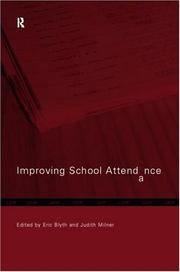
ISBN: 1134683170 1280334002 0203013344 020315889X 9780203158890 9780203013342 9786610334001 6610334005 9780415178716 0415178711 9780415178723 041517872X 9781134683178 9781134683123 113468312X 9781134683161 1134683162 041517872X 0415178711 9781280334009 1905538391 Year: 1999 Publisher: London New York Routledge
Abstract | Keywords | Export | Availability | Bookmark
 Loading...
Loading...Choose an application
- Reference Manager
- EndNote
- RefWorks (Direct export to RefWorks)
Although pupil disaffection has been a major concern to professionals, policy makers and researchers for quite some time, recent professional books in the area tend to focus on behaviour and exclusion from schools. Despite considerable government funding in both LEA's and schools- to promote new measures to improve school attendance, non-attendance at school is a relatively neglected topic as far as serious researched-based literature is concerned. This book will be the first in several years concerned with non-attendance. Previously unpublished research material in the book will provide a multi-disciplinary evaluation of practice at LEA, whole school and individual levels.
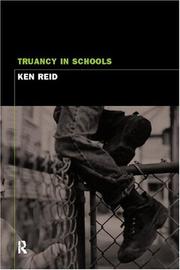
ISBN: 1134628080 1280328762 0203072146 9780203072141 0415205093 9780415205092 9786610328765 6610328765 9781134628032 9781134628070 9781134628087 9781138421493 1134628072 Year: 1999 Publisher: London New York Routledge
Abstract | Keywords | Export | Availability | Bookmark
 Loading...
Loading...Choose an application
- Reference Manager
- EndNote
- RefWorks (Direct export to RefWorks)
At present about one million pupils truant from their schools on a daily basis and this book examines why they do it. The numerous reasons for truanting discussed are: * disadvantageous home backgrounds * problems with settling in socially at school * poor performance in school * experiencing bullying in school * not coping with the transition from primary to secondary schooling. This book focuses on the social, psychological and educational causes of truancy. It examines recent research and gives many examples of good practice while also detailing the latest solutions
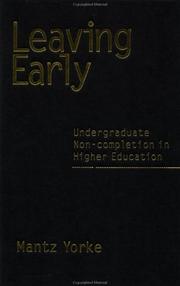
ISBN: 1135707235 1280402490 0203289285 0203209478 9780203209479 9780203289280 9786610402496 6610402493 9780750708975 0750708972 9780750708968 0750708964 9781135707231 9781135707187 1135707189 9781135707224 1135707227 0750708972 0750708964 9781280402494 Year: 1999 Publisher: London ; Philadelphia, PA : Falmer Press,
Abstract | Keywords | Export | Availability | Bookmark
 Loading...
Loading...Choose an application
- Reference Manager
- EndNote
- RefWorks (Direct export to RefWorks)
College attendance --- College dropouts --- College student attrition --- University dropouts --- College students --- Dropouts --- Academic probation --- Attendance, College --- College enrollment --- Probation, Academic --- University attendance --- School attendance --- College dropouts - Great Britain --- College attendance - Great Britain
Book
ISBN: 0948630752 Year: 1999 Publisher: London Museums & galleries commission
Abstract | Keywords | Export | Availability | Bookmark
 Loading...
Loading...Choose an application
- Reference Manager
- EndNote
- RefWorks (Direct export to RefWorks)
Museum attendance --- Museums --- Museum visitors --- Visitors, Foreign --- Public opinion
Periodical
Year: 1999 Publisher: Washington, D.C. : U.S. Dept. of Commerce, Bureau of the Census,
Abstract | Keywords | Export | Availability | Bookmark
 Loading...
Loading...Choose an application
- Reference Manager
- EndNote
- RefWorks (Direct export to RefWorks)
School attendance --- Education --- Students --- Demographic aspects --- Social conditions --- United States.
Book
ISBN: 2890529649 9782890529649 Year: 1999 Publisher: Québec : Boreal,
Abstract | Keywords | Export | Availability | Bookmark
 Loading...
Loading...Choose an application
- Reference Manager
- EndNote
- RefWorks (Direct export to RefWorks)
Social control --- Church attendance --- Contrôle social --- Pratique religieuse --- History --- Histoire --- Catholic Church --- Eglise catholique --- Church renewnal --- Protestant churches --- Contrôle social --- History. --- Social control - Quebec Province) --- Church attendance - Quebec (Province) --- Church renewnal - Quebec (Province) --- Protestant churches - Quebec (Province)
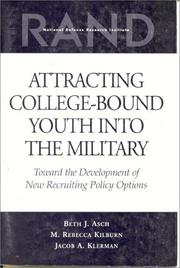
ISBN: 0585243476 9780585243474 0833027026 9780833027023 Year: 1999 Publisher: Santa Monica, CA RAND
Abstract | Keywords | Export | Availability | Bookmark
 Loading...
Loading...Choose an application
- Reference Manager
- EndNote
- RefWorks (Direct export to RefWorks)
College attendance --- Military & Naval Science --- Law, Politics & Government --- Military Administration --- United States --- Armed Forces --- Recruiting, enlistment, etc.
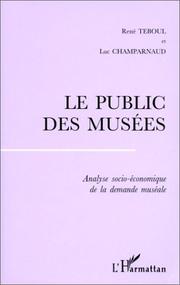
ISBN: 2738474179 9782738474179 Year: 1999 Publisher: Paris Harmattan
Abstract | Keywords | Export | Availability | Bookmark
 Loading...
Loading...Choose an application
- Reference Manager
- EndNote
- RefWorks (Direct export to RefWorks)
Museum finance --- Museums --- Museum attendance --- Museum visitors --- Musées --- Sociological aspects --- Economic aspects --- Aspect sociologique --- Aspect économique --- Sociological aspects. --- Economic aspects. --- Museums - France - Aix-en-Provence. --- Museums - France - Marseille. --- Museum finance - France - Aix-en-Provence. --- Museum finance - France - Marseille. --- Museum attendance - France - Aix-en-Provence. --- Museum attendance - France - Marseille. --- Museum visitors - France - Aix-en-Provence. --- Museum visitors - France - Marseille.
Book
Year: 1999 Publisher: Washington, D.C., The World Bank,
Abstract | Keywords | Export | Availability | Bookmark
 Loading...
Loading...Choose an application
- Reference Manager
- EndNote
- RefWorks (Direct export to RefWorks)
A revised version was published as The Allocation and Impact of Social Funds: Spending on School Infrastructure in Peru (with Christina Paxson). World Bank Economic Review 16 (2): 297-319, 2002. Education projects of the Peruvian Social Fund (FONCODES) have reached poor districts and, to the extent they live in those districts, poor households. FONCODES has had a positive effect on school attendance rates for young children, but not on the likelihood that children will be at an appropriate school level for their age. Since its creation in 1991, the Peruvian Social Fund (FONCODES) has spent about USD 570 million funding microprojects throughout Peru. Many of these projects have involved building and renovating school facilities. Paxson and Schady analyze the targeting and impact of FONCODES investments in the education sector, using data from FONCODES, Peru's 1993 population census, Peru's 1994 and 1995 Living Standards Measurement Surveys, and a 1996 household survey conducted by the Peruvian Statistical Institute. They present their results based on various descriptive and econometric techniques, including nonparametric regressions, differences-in-differences, and instrumental variables estimators. They show that FONCODES projects in the education sector have reached poor districts and, to the extent they live in those districts, poor households. FONCODES has had a positive effect on school attendance rates for young children, but not on the likelihood that children will be at an appropriate school level for their age. Among other recommendations, they suggest that FONCODES consider random assignment of some education projects for a subsample of the population, to test the robustness of the study's assumptions and results. Lack of disaggregated data on such measures as the time children spend in school, pupil-teacher ratios, and scholastic achievement precluded analysis of the impact of FONCODES education projects on school quality. Collecting such data, and understanding how improvements in school infrastructure interact with other school-level changes to produce more learning, should be a research priority. This paper - a product of the Poverty Division, Poverty Reduction and Economic Management Network - is part of a larger effort in the network to understand the functioning and impact of social funds.
Access To Schooling --- Attendance Rate --- Attendance Rates --- Classrooms --- Communities & Human Settlements --- Disability --- Education --- Education for All --- Educational Infrastructure --- Educational Inputs --- Educational Outcomes --- Finance and Financial Sector Development --- Financial Literacy --- Gender --- Gender and Education --- Health, Nutrition and Population --- Housing and Human Habitats --- Illiteracy --- Investments In Education --- Population Policies --- Poverty Monitoring and Analysis --- Poverty Reduction --- Primary Education --- Public School --- Rural Development --- Rural Poverty Reduction --- Sanitation --- School --- School Attendance --- School Breakfast --- School Facilities --- School Level --- Schoolchildren --- Social Protections and Labor --- Tertiary Education --- Textbooks --- Values

ISBN: 0521578280 9780521570589 0521570581 9780521578288 1107113377 0511007744 0511171889 0511309651 0511149425 0511605633 1280429151 0511053622 9780511007743 0511038380 9780511038389 9780511605635 9780511149429 9781280429156 9780511171888 9780511309656 9780511053627 9781107113374 Year: 1999 Volume: 15 Publisher: Cambridge, U.K. New York Cambridge University Press
Abstract | Keywords | Export | Availability | Bookmark
 Loading...
Loading...Choose an application
- Reference Manager
- EndNote
- RefWorks (Direct export to RefWorks)
Robin Gill argues that once moral communities (such as churchgoers) take centre stage in ethics - as they do in virtue ethics - then there should be a greater interest in sociological evidence about these communities. This book, first published in 1999, examines evidence gathered from social attitude surveys about church communities, in particular their views on faith, moral order and love. It shows that churchgoers are distinctive in their attitudes and behaviour. Some of their attitudes change over time, and there are a number of obvious moral disagreements between different groups of churchgoers. Nonetheless, there are broad patterns of Christian beliefs, teleology and altruism which distinguish churchgoers as a whole from non-churchgoers. However, the values, virtues, moral attitudes and behaviour of churchgoers are shared by many other people as well. The distinctiveness of church communities in the modern world is thus real but relative, and is crucial for the task of Christian ethics.
316:2 --- 316:2 Godsdienstsociologie --- Godsdienstsociologie --- Christian ethics --- Christians --- Church attendance --- Public opinion --- Attendance, Church --- Church-going --- Church membership --- Public worship --- Religious adherents --- Ethical theology --- Moral theology --- Theology, Ethical --- Theology, Moral --- Christian life --- Christian philosophy --- Religious ethics --- Attitudes --- Great Britain --- Morale chrétienne --- Théologie morale --- Opinion publique --- Pratique religieuse --- Arts and Humanities --- Religion --- Public opinion. --- Attitudes.
| Listing 1 - 10 of 18 | << page >> |
Sort by
|

 Search
Search Feedback
Feedback About UniCat
About UniCat  Help
Help News
News